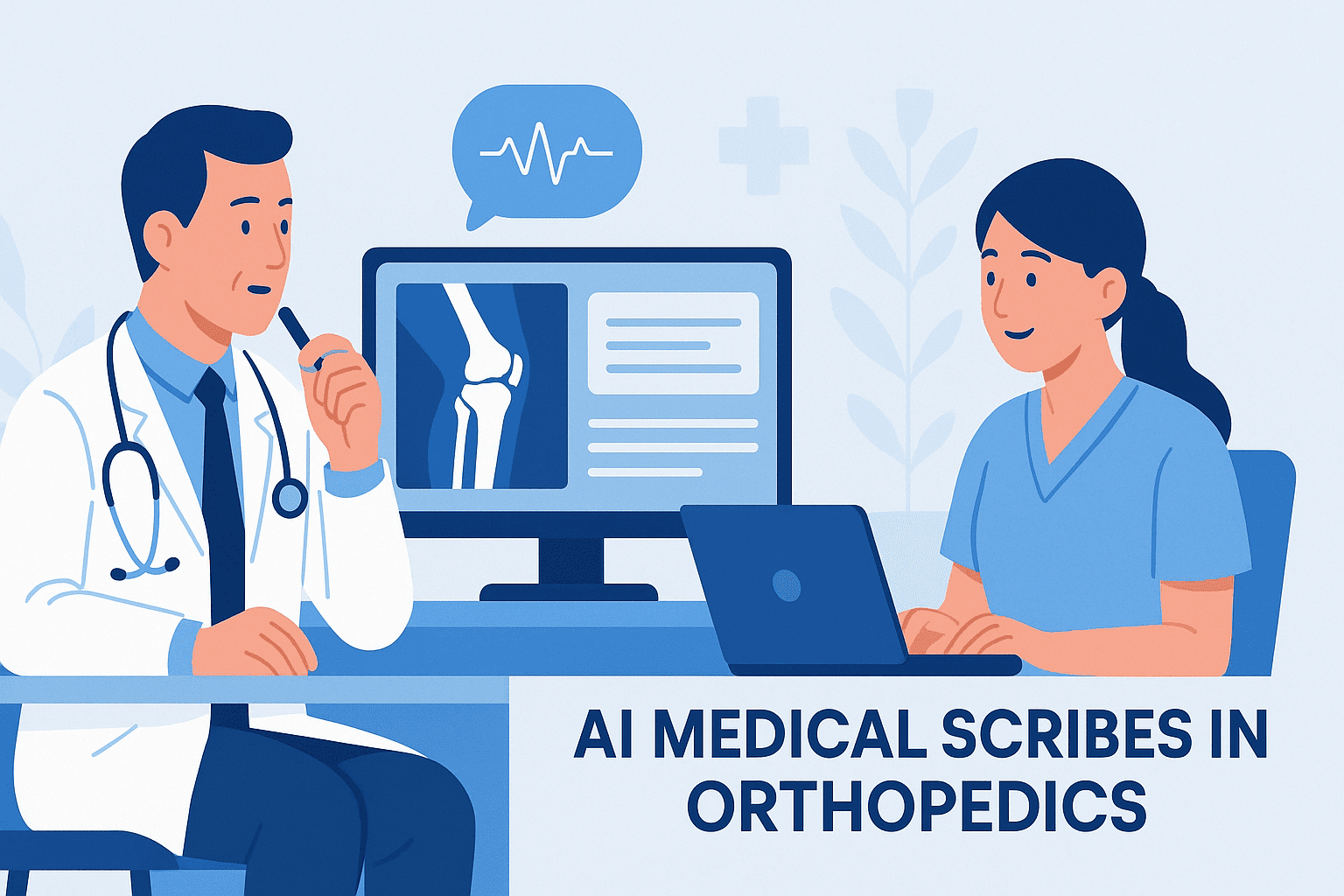Updated on: July 12, 2025
Whether it’s a torn ACL, a complex joint replacement, or a simple fracture follow-up—orthopedic care demands detailed, high-volume documentation. From physical exams to imaging results to post-operative plans, orthopedists are expected to capture every clinical nuance… all while juggling packed schedules.
But the more you treat, the more you type. That’s where AI medical scribes for orthopedics step in.
Solutions like DocScrib are revolutionizing how orthopedic surgeons, sports medicine specialists, and physical medicine providers document care—automating tedious tasks so they can focus more on patients and procedures.
Why Orthopedic Documentation Is Especially Complex
Orthopedists don’t just treat—they analyze motion, perform surgery, interpret radiology, and manage rehabilitation timelines. A typical orthopedic note may include:
-
Range of motion measurements
-
Imaging interpretations (X-ray, MRI, CT)
-
Physical exam findings (e.g., Lachman’s test, impingement signs)
-
Injury mechanism & sports-specific detail
-
Operative notes and pre/post-op instructions
-
Complex procedure coding (CPT, ICD-10)
All of this makes orthopedic documentation not only time-consuming—but easy to get wrong if rushed.
Enter AI-Powered Orthopedic Scribes
AI orthopedic scribes like DocScrib are trained on the unique language and workflow of musculoskeletal medicine. Instead of just transcribing audio, they understand and structure notes for maximum clarity, compliance, and speed.
With real-time audio capture, natural language processing (NLP), and customizable templates, orthopedic AI scribes can:
-
Generate SOAP or surgical notes in minutes
-
Auto-populate fields like range of motion or strength grading
-
Sync seamlessly with your EMR (Epic, Athena, Cerner)
-
Suggest CPT codes based on procedures described
How DocScrib Works for Orthopedic Practices
-
Clinician begins consultation—the AI listens in via mobile or desktop mic.
-
DocScrib parses clinical conversation in real time, capturing subjective complaints, objective findings, and procedural planning.
-
Note is generated using orthopedic-specific templates (H&P, post-op, physical exam, etc.).
-
Clinician reviews, edits if needed, and signs off.
-
Documentation is instantly synced to the EMR.
This entire process often takes under 3 minutes.
Benefits of AI Scribes in Orthopedic Workflows
🦴 Faster Physical Exam Documentation
Capture detailed descriptions of joint function, gait, deformities, and test results without typing.
🛠️ Streamlined Operative Notes
AI scribes record surgical plans, intraoperative findings, implants used, and complications—saving hours in post-op documentation.
🕒 Up to 2 Hours Saved Daily
Orthopedists see high patient volumes. AI scribes give them back time between consults and after clinic hours.
🏃♂️ Improved Sports Medicine Notes
Detailed mechanism of injury, activity-specific limitations, and return-to-play timelines—all automatically structured.
🔍 Imaging Summary Assistance
Scribes can assist with documentation of X-ray, MRI, or ultrasound interpretations with anatomical specificity.
🔐 HIPAA-Compliant
DocScrib keeps all orthopedic patient data secure with end-to-end encryption and audit-ready records.
DocScrib Orthopedics: Feature Highlights
At DocScrib, we’ve optimized our AI platform for orthopedic use cases:
-
Range of Motion Fields with automatic grading input
-
Ortho-Trained NLP for terminology like valgus deformity, osteophytes, or meniscal tear
-
Procedure-Specific Templates (arthroscopy, fracture reduction, joint injections)
-
Customizable Follow-Up Notes for rehab plans and physical therapy updates
-
Outpatient & Surgical Workflow Support
-
Implant Tracking & Device Notes
Common Orthopedic Use Cases for DocScrib
-
Clinic Visits: Knee pain, shoulder instability, back issues, or fractures
-
Pre-Operative Assessments: Consent review, surgical planning
-
Operative Reports: Arthroscopies, joint replacements, ligament repairs
-
Post-Op Follow-Ups: Healing status, wound care, mobility tracking
-
Sports Physicals: Performance metrics, clearances, rehab milestones
Real-World Outcome: AI Scribe in a Busy Ortho Clinic
📍 Case Example: A high-volume orthopedic group in Texas implemented DocScrib across 3 providers.
Results in 30 Days:
-
18% increase in daily patient throughput
-
90% reduction in after-hours charting
-
Fewer coding errors and billing denials
-
Surgeons noted improved patient interaction due to less screen distraction
💬 “The AI picks up everything—even ROM scores and test findings. It’s like having a trained scribe who never misses a shift.”
DocScrib vs. Traditional Orthopedic Scribes
| Feature | Human Scribe | DocScrib AI Scribe |
|---|---|---|
| Cost per Month | High (salary/contract) | Affordable SaaS pricing |
| Ortho Terminology Trained | Maybe | ✅ Yes, with NLP tuning |
| Availability | 9–5 or shift-based | ✅ 24/7, on-demand |
| Imaging & Procedure Integration | ❌ Manual | ✅ Smart extraction |
| EMR Integration | Manual entry | ✅ 1-click sync |
FAQs About Orthopedic AI Scribes
Q1. Can AI capture exam details like strength, ROM, and special tests?
Yes. DocScrib is trained to detect and document metrics like 5/5 strength, 130° knee flexion, or positive McMurray’s.
Q2. What about operative documentation?
DocScrib supports intra-op and post-op summaries, including CPT code suggestions and implant logs.
Q3. Does it work with PACS or imaging software?
While DocScrib doesn’t interpret imaging, it can transcribe your verbal interpretation for structured note entry.
Q4. Can I use it in the OR, clinic, and telemedicine?
Yes—DocScrib works across devices and locations, including surgery centers, exam rooms, and virtual visits.
How to Get Started with DocScrib for Orthopedics
You can implement DocScrib in under 48 hours:
-
Choose your specialty as Orthopedics
-
Set up templates for common procedures and clinic visits
-
Connect your EMR
-
Start your consults—DocScrib listens, writes, and saves
⚡ Ready to reclaim your evenings and run a smoother practice?
Conclusion: Let the AI Handle the Typing—You Handle the Healing
Orthopedic practices thrive on precision and productivity. With AI scribes like DocScrib, you get the power of ambient listening, medical language processing, and surgical note generation—all in one tool.
Spend less time on admin. See more patients. Improve documentation accuracy. And get back to what you do best—getting people moving again.
🏃♂️ Try DocScrib for Orthopedics Today → Book a Demo
